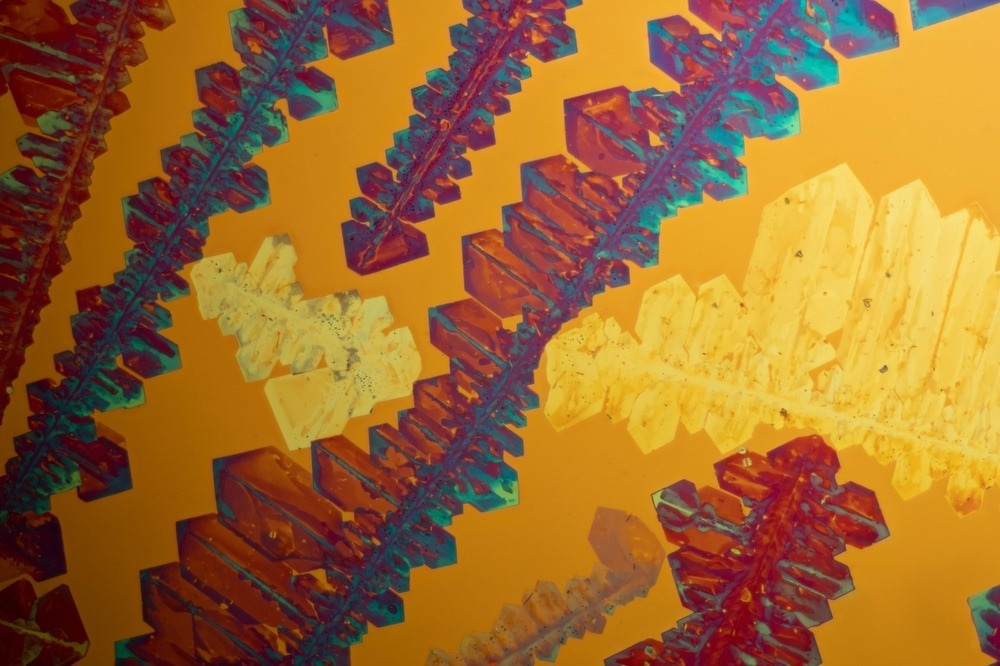Chiral compounds have a ubiquitous existence in nature, and chirality has a vital role in biological processes, chiral drugs, and chiroptical materials. Consequently, it is critical to determine the enantiomeric ratio (ER) in chiral compounds in both scientific and industrial fields. To this end, various chiral separation techniques are available to separate chiral compounds into individual enantiomers and obtain enantiopure compounds.

Image Credit: Phoenix1/Shutterstock.com
High‐performance liquid chromatography (HPLC) and chiral gas chromatography (GC) are two methods of separation extensively used in synthetic, pharmaceutical, medicinal, and supramolecular chemistry. Understanding the underlying enantioselective supramolecular separation mechanisms helped develop new chiral stationary phases in GC.
Chiral Stationary Phases and its Working Mechanism
Modern chiral stationary phases allow rapid ER analysis and are applied to separate a wide range of chiral compounds. ER determination via chiral stationary phases allows facile assignment of absolute configurations for known compounds used in reaction upscaling and separation of enantiomers, thus saving time and resources in the drug lead development process.
Consequently, these chiral stationary phases enabled scientific progress in many fields of synthetic chemistry, including catalysis, assignment of relative and absolute configurations, asymmetric synthesis, and asymmetric organocatalysis. Additionally, chiral stationary phases allow the qualitative analysis of materials for their physical organic properties, dynamic behavior of interconverting enantiomers, and supramolecular interactions.
The underlying principle of the separation of enantiomers via chiral stationary phase in GC is “chiral recognition”. The enantiomers form an adduct with chiral selectors of the stationary phase, resulting in the formation of transient diastereomeric complexes. This method enables the establishment of equilibrium in each theoretical separation plate in the GC column. Thus, a GC capillary column with 1000 to 5000 theoretical plates per meter can achieve superior separation, which is observed irrespective of the energy difference between the transient diastereomeric complexes formed in the column between enantiomers and chiral selectors.
Chiral recognition in GC is achieved via a three-way interaction between selector and selectant due to binding and nonbinding interactions. The two types of transient diastereomeric adducts (due to binding and nonbinding interactions) formed vary in terms of their thermodynamic properties. Therefore, the formed transient diastereomeric adducts have different retention times during the separation via GC.
High efficiency, rapid separation, and sensitivity are the primary advantages of separating enantiomers via GC. Integrating GC with mass spectrometry (GC-MS) allows the detection of analytes without ambiguity. Furthermore, utilizing the selected ion monitoring (SIM) mode in GC-MS enables the detection and identification of enantiomers even in trace amounts.
Chiral Stationary Phases
Chirasil-Valine is a diamide selector with excellent chiral recognition properties towards nitrogen (N) (oxygen (O), sulfur (S))-pentafluoropropionyl/ isopropyl esters derived from canonical amino acids. Diamides form insoluble solids due to the intermolecular complex formation and the high polarity of the two interacting diamide bonds which is a challenging issue. The diamide selector must exist in the liquid state to use the valine-diamide selector as a chiral stationary phase in GC and facilitate efficient separation of enantiomers.
Cyclodextrins have a high ability to form selective inclusion complexes. Hence, these cyclodextrins are considered a chiral stationary phase in GC. Previous reports mentioned the interactions of cyclodextrin-based columns with chiral analytes such as alpha (α)- and beta (β)-pinene and various nonchiral analytes. Coating the capillary columns with liquid derivatized cyclodextrins and cyclodextrins dissolved in polysiloxane polymer resulted in high separation efficiencies.
Chiral metal-chelates are versatile chiral selectors utilized in enantioselective complexation in GC. Rare earth metal and chiral transition metal complexes like metal 3-(trifluoroacetyl)-(1R)-camphorates are used as chiral stationary phase and can achieve high enantioselectivities in separating chiral compounds.
Recent Trends
In a recent article published in the Journal of Chromatography A, chiral hydrogen-bonded organic framework (HOF) was explored as a novel stationary phase for GC. A wide range of analytes, including n-alkanes, n-alcohols, polycyclic aromatic hydrocarbons, and positional isomers, especially for racemates, the HOF column showed excellent separation repeatability and reproducibility. The relative standard deviation (RSD) values for the retention times were in the range of 0.37–2.43% for a run-to-run, 0.38–2.51% for day-to-day, and 0.31–2.54% for column-to-column, respectively. Moreover, the density-functional theory was applied to calculate the adsorption of enantiomers in HOF structures. This work proved that the HOFs had application prospects as a stationary phase in GC.
In another article published in the journal Chirality, a covalent organic framework (COF-TpBD (NH2)2) was prepared using monomer 2,4,6-trihydroxybenzene-1,3,5-tricarbaldehyde (Tp) and 3,3'-dinitro[1,1’-biphenyl]-4,4’-diamine (DNB) followed by reduction using anhydrous tin chloride (SnCl2). The synthesized COF-TpBD (NH2)2 were modified with L-valine trifluroacetyl derivative, L-hydroxyproline, and (1S)-(+)-10-camphorsulfonyl chloride and were used as stationary phases to separate some chiral compounds, positional isomers, n-alkanes, n-alcohols, aromatic hydrocarbon mixture, and Grob's reagents. The results revealed that the chiral derivatives of COF-TpBD (NH2)2 had good separation ability and chiral recognition in GC.
Conclusion
Overall, the scientific development of chiral GC has progressed due to the discovery of various synthetic chiral stationary phases over time and their applications or integration into advanced analytical techniques. These developments were beneficial for scientific progress due to facile detection and separation of various medicinally or industrially important chiral molecules into their respective enantiomers.
More from AZoM: Reflection Electron Microscopy for Crystal Analysis
References and Further Reading
Betzenbichler, G., Huber, L., Kräh, S., Morkos, M. L. K., Siegle, A. F., Trapp, O. (2022). Chiral stationary phases and applications in gas chromatography. Chirality.https://doi.org/10.1002/chir.23427
Wang, W., Zhang, Y., Tang, B., Hou, H., Tang, S., Luo, A. (2022). Chiral Hydrogen-bonded Organic Frameworks used as a chiral stationary phase for chiral separation in gas chromatography. Journal of Chromatography A. https://doi.org/10.1016/j.chroma.2022.463150
Wang, Z., Xiong, W. Q., Huang, Z. F., Qin, G. Z., Zi, M., Yuan, L. M. (2022). Chiral derivatives of covalent organic framework TpBD (NH2)2 used as stationary phases in gas chromatography. Chirality. https://doi.org/10.1002/chir.23408
Disclaimer: The views expressed here are those of the author expressed in their private capacity and do not necessarily represent the views of AZoM.com Limited T/A AZoNetwork the owner and operator of this website. This disclaimer forms part of the Terms and conditions of use of this website.